Petra Jordan– that is all I knew about the heritage site before I received an invite from Jordan Tourism to visit the country. The image of rose-tinted pillars called treasury evoked a curiosity that would attract any traveler to Petra Jordan. We were all excited about being at the world heritage site. To the extent that we tried hard to negotiate with our guide to leave early morning. So that we can spend a couple of extra hours admiring the pink sandstone city that remained lost for a long time.
Petra Jordan Tour
Our guide was probably used to enthusiastic travelers like us. And he weaved a story to ensure we leave Amman at his chosen time only. Technically Petra belongs to the city of Ma’an and the village of Shobak. And lies in the Southern part of Jordan, about a 3-4 hour drive from the capital city of Amman.
The first sight of Petra – the Lost City of Nabataeans

We reached Petra a little before noon and bought our ticket at JD 90 (1 JD = 100 Rs at the time of writing ) per person. It is probably the highest-ticketed UNESCO World Heritage site that I have visited so far. All excited to be finally at the door of the heritage site, we started walking towards what I expected to be a set of monuments. Though all my friends who had visited before warned me about being prepared to walk a lot, turned out to be a sprawling city. We started walking on the rough road with carved hills on both sides. There were square tombs carved out of the hills with omens and signs carved and painted on them. Carvings stay on while the paintings are left only as a faint version of themselves.
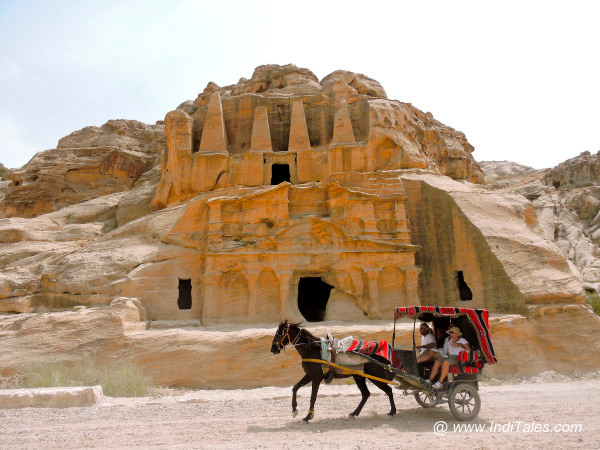
Colorful Tongas carried people who wanted to avoid walking. It is a good kilometer or so before you reach the Siq, the narrow pathway that leads to the heritage site – the rose-tinted city. We obviously decided to walk as our guide started telling us about the history of world heritage. And its mention in the Bible that indicates that it was a living city during those times. Petra is a Greek word that literally means ‘The Rock’. Once you have seen the place you know there is no better name for this city.

After it was re-discovered in 1812 CE by a Swiss Johann Ludwig, Petra is fondly called ‘the Rose City’ for its rose-tinted color of the rock. Or even ‘The Lost City’ for it was lost to the world for many centuries.
The capital of the Nabataean Civilization
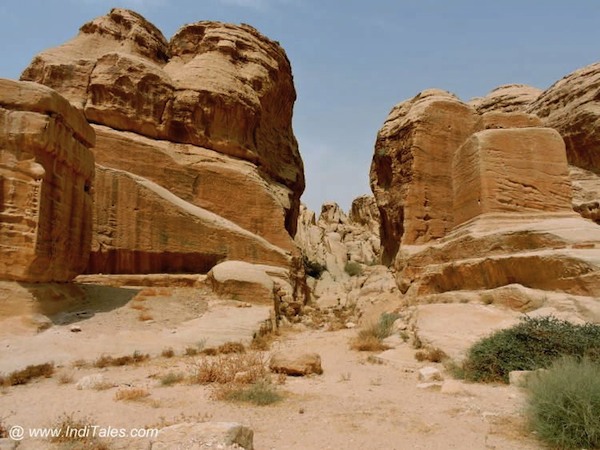
Petra at its peak was the heart and home of the Nabataean civilization. Historians have agreed that the history of the heritage city starts around 312 BCE. This was where the trading tribe of Nabataeans lived. And they traded with both the Arab world in the South, with Egypt along the Dead Sea, and even with Romans. Trade routes with India are also documented. Nabataean people came from Arabian roots and worshiped a God named Dushara which is equivalent to Zeus or Jupiter in Greco-Roman mythology. They also had a female goddess equivalent of Aphrodite. Like Zeus, Dushara also lived on a mountain nearby. It made me think that even our Gods prefer living in the mountains like Shiva on Kailash.

Nabataeans lived here till 106 CE when the Roman Empire took over. The excavations show the signs of Roman days in their ruins as much as they show the signs of Nabataeans. The presence of churches in the complex indicates the adoption of Christianity by the Nabataeans in the early 1st CE.
The Siq

After you have walked about a kilometer on the dirt road, you see the Grand Canyon like a parting in the hill. It almost feels like the hill has torn itself to make way for the guests. In fact, this partition happened naturally as a result of a massive earthquake. If you look carefully, you will see that the two sides of the Siq could fit into each other like pieces of a jigsaw puzzle.

This partitioned passageway is about 800 meters long. And has a unique characteristic to it. A narrow strip of light comes from the top and illuminates the rocks. While at the ground level, you only see the sun and do not feel it. Being a natural corridor, it is the coolest part of the heritage city.
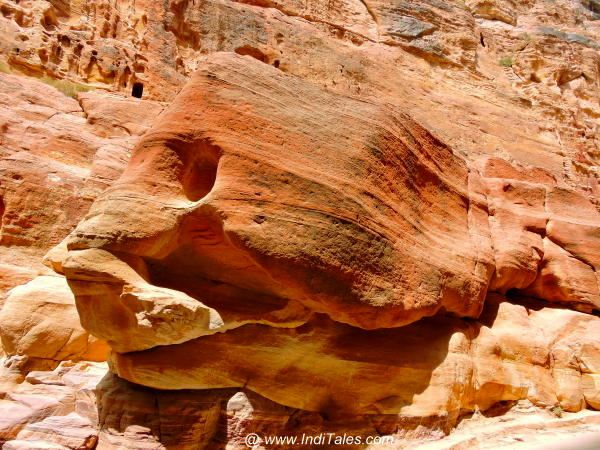
There are many natural formations that are intriguing like the mouth of a fish in one place. There are many man-made sculptures that you can see and admire like altars with images on the walls – that I assume belong to the deities that were worshiped here. I wish I could understand the stories behind them. But given the limited time, we had there it was not possible to dig into each of them. I am surprised by the very limited availability of documentation on the internet.

It is believed that Nabataeans used this natural walkway to their advantage by using it as an entrance to the city. The narrow path ensured that the city couldn’t be invaded easily.

Water Management at Petra Jordan
What you must see and admire while walking through the Siq are the water channels that you can see on both sides of the walls. One of them is made of terracotta and acts as a natural filter for drinking water. And the other is made of limestone. In fact, the reason the site was inhabited for so long despite being a part of the desert is its water management system. A tour of water management at the site can be an exploration in itself. It is said that the 6 inches of rainfall that the area received were stored and managed in such a way that residents had enough water for the whole year. This reminded me of all the water management systems in ancient India like Rani Ki Vav or Sahastralinga Talav.
Petra Treasury

The Treasury monument is the face of Petra. It is the first site you see on the other side of Siq. Through a narrow corridor, a couple of rose-colored pillars make the first appearance. And as you get close you find yourself standing in front of that whole façade. It is like a dream come true. The rose-colored soft sandstone structure is carved like a Greco-Roman temple. However, this is just a facade. Local Bedouins thought there must be a treasure hidden behind such a nicely carved façade so they started calling it treasury. In reality, it is the tomb of an important Nabataean King. So are most other carved facades. At the Treasury, you can go close to it and see the graves below.

Unlike most ancient civilizations that believe in life after death and have rituals to carry the soul to the next life, Nabataeans seem to believe in heaven and hell. You can see crow steps carved on top of each of the tombs and they supposedly take you to heaven or hell.
The Treasury and other facades like it have been carved top to bottom just like our Kailash Cave at Ellora was carved top-down. Just like we found the construction methodology of Ajanta Caves from the unfinished caves, archaeologists discovered that these facades have been carved top down. And that is why a lot of them have a second story but no first story.
Architectural details

Relief sculptures on the facade of the Treasury monument carry influences from 5 different civilizations that lived here.
There are 6 tall pillars in front of the first story of the treasury. Between the two extreme pillars on either side, you can see a knight riding a horse. They come from Roman mythology and are called Castro and Polix – sons of Zeus and a human girl. The capitals of these pillars are Corinthian and that is a Greek influence. On the second floor, there is an Egyptian goddess Ezes carved.
On top of the Corinthian capital, you can see 7 cups and above that 30 roses. 6 pillars on each floor making it 12 pillars in total and then there are teeth-like carvings that total 365. Do you see a calendar carved here?
Till about 10 years ago tourists were allowed to go inside. But since the graves beneath this facade have been discovered, tourists are not allowed to go inside.
A curious fact about treasury is that it is the best-preserved facade in the whole of the world heritage site and there is a simple scientific reason for it. The wind from the Siq hits the walls around the treasury but not the facade. That protects the facade from killing climatic conditions.
Caves

The irony is that all the decorated facades are burial sites and celebrate the dead people. While the small holes in the mountains are the caves where the people lived. You just cannot miss the irony – giant ornate decorated sites for the dead. And almost a hole in the hill as the living places of the people.
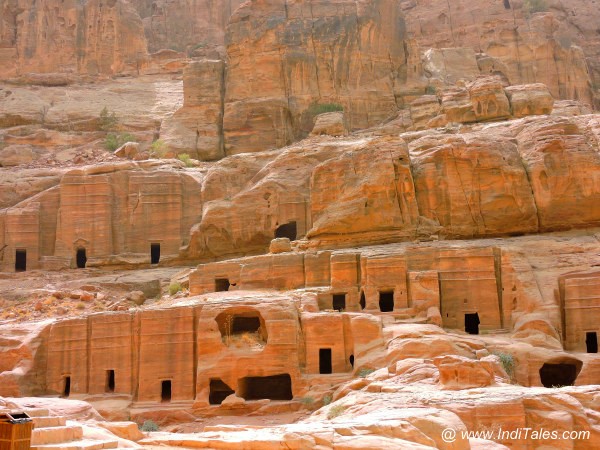
Local tribes like Bedouins lived here till as late as 1985. When they were moved out to get a UNESCO World Heritage site status. Even today you meet people who claim to live in these caves. Some tour guides offer you a stay in the cave, but then not really officially.
Bedouins

Bedouins did a smart thing when they were moved out, they negotiated that they would be the only ones providing services to the tourists inside the heritage city area. So you can see them driving Tongas, offering rides on camels and Ponies. Selling Jordan souvenirs in their tents. There is one good restaurant towards the southern end. Small shops here and there but nothing much in the name of tourist facilities. In fact, our guide opined that since Bedouins have a monopoly, the quality of services provided is both average and costly.
Imagine paying a hefty amount for the ticket and then paying an equivalent amount for various rides within the city. I also found them very rude. One of the Pony drivers got angry with me for the simple reason that I decided to walk and not hire him. He tried to scare the hell out of me with his friends. This was towards the evening and there were not many tourists around.
Theater

Commonly known as Roman Theater due to its resemblance with the more popular Roman theaters, this is also a misnomer. The theater belongs to the Nabataean period as well. The most remarkable thing about this theater is that it is a rock-cut theater built by chopping off the rock. Do you know of any other theater built like this?
Unfortunately, the theater is in a dilapidated state. And does not really represent the state it would have been when 6000-odd people could sit here to be entertained.
Temple of Dushara
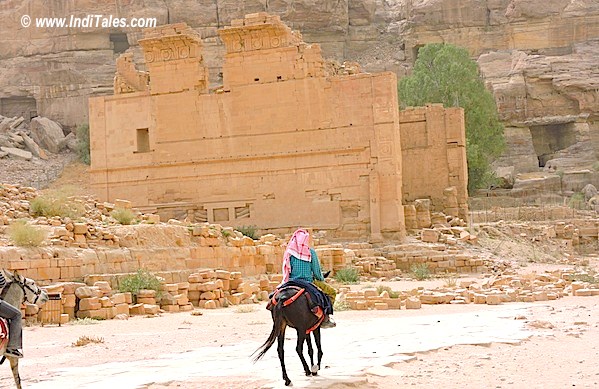
If it were intact, this would be the biggest structure or façade on the heritage site. Unfortunately, what remains are absolute ruins. Archaeologists compare this to the temple of Artemis in Jerash or the Temple of Hercules in Amman Citadel but only much larger than them.
Royal Tombs

As you walk inside the heritage city after crossing Al Khazaneh or the Treasury, on the right-hand side, perched on hilltops you would see a series of royal tombs with facades very similar to that of Treasury. You need to climb a few hundred steps to reach the base. I had a choice between climbing these steps and climbing the steps to the monastery and I chose the latter. The tombs look impressive in perspective. Inscriptions inside these tombs tell about the timeline of these tombs. And the kings buried here – most of them belong to the Nabataean Kings.
Most buildings got their name from their color or their shape. For example, a building with a color like silk was called a Silk Tomb. One with Corinthian pillars was called Corinthian. The one that looked like a palace was called Palace. But these names have no bearing on either the original names or the purpose of the building.
A walk to the Petra Monastery

The monastery is another carved façade – it may have been a temple at some point. But as it stands today, it has absolutely plain interiors and a nicely carved façade. You need to climb 800+ uneven steps from the base to reach the monastery. On the way, you meet many Bedouins in their tents. Some play musical instruments, some offer you tea but mostly sell jewelry and red and black garments. I noticed that women managed most tents while men or rather boys ferried the tourists up and down on ponies.

Besides the intricate rock formations, you notice the colors – bright yellow and pink on some of the rock faces. My initial instinct was that these colors are courtesy of some human activity. But then I discovered that the sandstone here has layers of color in it at various places. I looked inside many caves and saw several patterns formed by colors. I wish I had a geologist to explain this phenomenon.

Bang opposite the monastery is a Bedouin tent café – a perfect place to recharge yourself with some tea/coffee. And admire the symmetric beauty of the monastery. We saw a young Bedouin man named Moon jumping from one part of the monastery to another – an act that left most of us in awe of him. He would have remained a hero in my memories had he not harassed me on my way back for not hiring his pony.
Little Petra

It is located about 8 kilometers north of Petra. And looks like a little suburb. Little Petra as the name suggests is similar in formation but much smaller in size. To me, it had far more character. Maybe because there is so much hype around Petra that it can be a bit underwhelming to some, but I was jumping with joy here. It has a similarly carved façade with graves. It has very Ajanta-like caves with stone carved to be like a bed or a table. This looked like a place where the ancient civilized people might have lived. Archeologists guess that this might have been a place for traders to stay as it was on the silk route and as we know Nabataeans were traders.
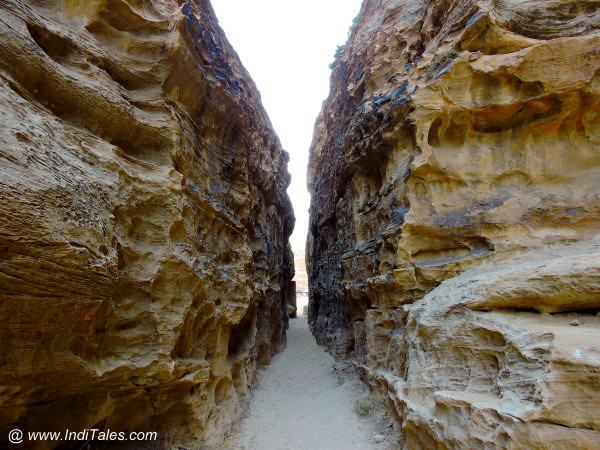
Little Petra also called Siq al-Barid, has a canyon-like rock partition though not as tall and narrow as Siq at Petra. The rocks on both sides are carved and here and there you see a carved façade looking at you. Apparently, there are some painted caves too. But my guide forgot to mention them and I missed the rare frescos from the Nabataean period. Little Petra is also a UNESCO World Heritage site.

Entry is free and it is open to the public during the day. You can also approach it from a hiking trail but not without a guide.
If I ever get to go back to Jordan, I would love to spend some more time here. My strong recommendation is – Do not miss Little Petra.
Practical Tips
- Carry a bottle of water.
- Wear comfortable walking shoes.
- Use the washroom at the ticket counter; the next washroom is quite some distance away.
- Visit as early in the morning as possible, towards the latter half of the day there are not many people and locals can get rough with you. Also, you will get good light for your photographs in the morning.
- Unless you are traveling solo, stay with your group.
- Read about the important sites within the world heritage site and decide what you must see, what you can let go of, and what you will see if you have energy left.
- Choose a combination of walking, Pony Ride, and Horse carts based on your fitness levels.
- Local Bedouins can push you a lot in selling things including rides, but ignore them politely.
- I could not find a reliable source to read about the heritage place in detail. So hire a guide who can explain to you the nuances of the architecture there and tell you stories from its various eras.
Read My Travel blogs on Jordan.
Hejaz Railways – Heritage Rail







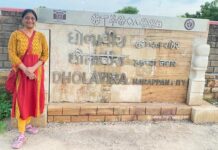







Truly excellent blog post. Kate visited Petra in 2001 and had a similar experience. Reading your post provided a vivid reminder of that experience. Thank you for writing diwn all the history!
So happy that you enjoyed the post Kate and Mike. The older the place is, more it fascinates me. Stay Connected.
Comprehensive coverage of Petra.
Thanks Niranjan. Like another blogger said – Inditales is actually In Details… 🙂
Nice capture and lovely account of the entire city.
Thanks Ami, Petra is a site that you must visit once in your life time.
Oh, beautiful pics! Jordan has been on my list for so long – hope this visit comes soon 🙂
How come Petra missed you for so long Charu 🙂
I visited Petra a few months ago with my family and spent 3 days explore ring the ruins and little Petra. I didn’t experience rude guides, but I loved the site and it was far more than I ever imagined.
Kevin, I found little Petra far more endearing though my favorite site in Jordan is Jerash – an adorable ancient Greco-Roman city. Petra was nice – its water management feature was the most fascinating for me.
Very nice! Jordan is a place high on my dream bucket list. Thanks for sharing!
Thanks Majesta. You must visit Jordan at least once in your life time & welcome to IndiTales.
Nice guide to Petra. I enjoyed all the historic details and the great photographs. I just came back from Petra/Jordan last month and actually just wrote two entries on Jordan itself on my own blog. Did you feel like you had enough time to see Petra in one day? I didn’t feel like it was enough time.
Nope, I think you need at least 2-3 days to explore the Petra at leisure, to see the hidden corners, to get into those caves where civilization thrived. In a day you just do the touristy circuit. But then this site is so damn costly to enter everyday.
Your photos are beautiful and really capture how smooth and well preserved the facades are. I live in an area well-known for red rock, but we have nothing carved in so intricately. Amazing.
Thanks Michelle – to see the real carving on hard stone, you need to visit Ellora in India – you would be spellbound at the technology used to cut the monolithic rock and carve out and intricately carved rock from it – see here – https://inditales.com/kailash-cave-ellora/
Petra is something I’m looking forward to visit for ages! My only fear now is that some terrorists could destroy that site too, so that no one could ever see it again.
Luca, Petra is too big a site and it is anyways ruins. Lets hope for the best and yes, visit it soon. Come back and tell us about your experience of visiting it.
Hi. Where can i purchase a hanging souvenir plates of Petra,Jordan at least 5 inch size,
Hi Helen, They are available in most souvenir shops across Jordan. They are most common of Jordan souvenirs people pick up. I too picked up one.
Wonderful, surprising, marveles countless wonders in this world which made by God!! Always feels happy with this wonders. Madam my heartful greetings to you for Your work and describe each part and also your interest, skill photography etc…
Thank you Uma ji. It is encouragement like this that keeps us going.
Petra looks absolutely stunning! Your guide to the attractions is so detailed and helpful. I’d love to visit someday and experience its history and beauty in person!